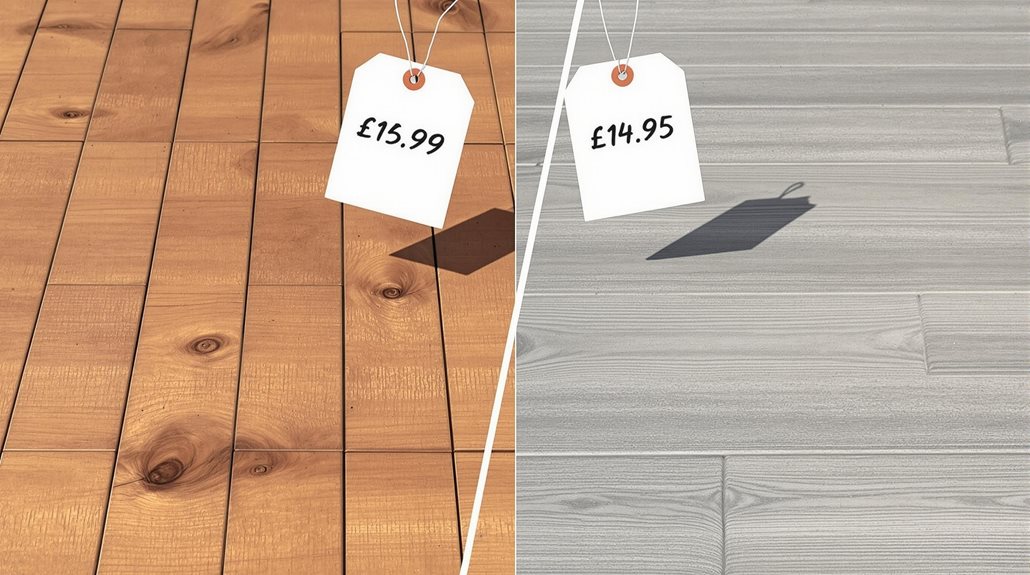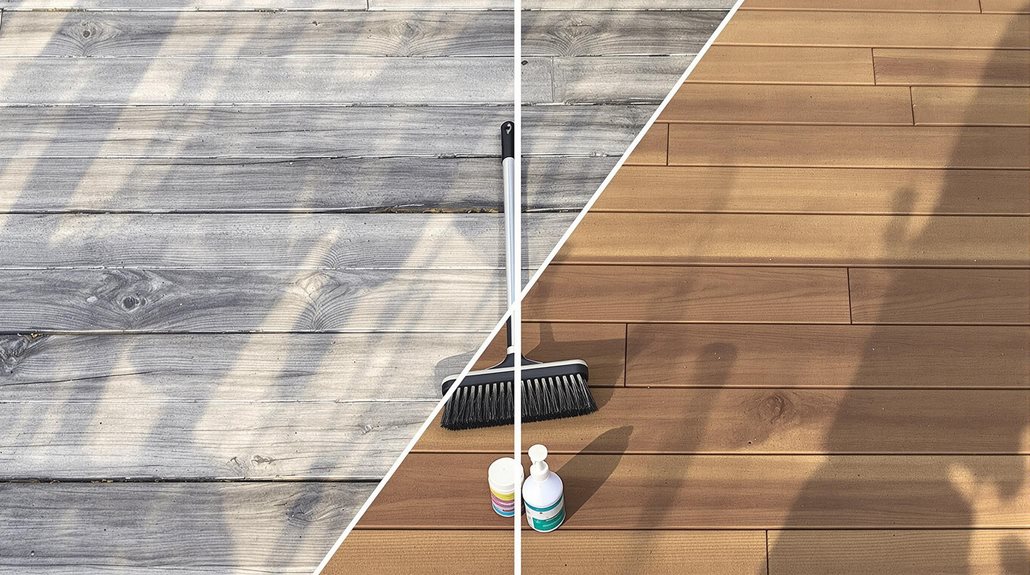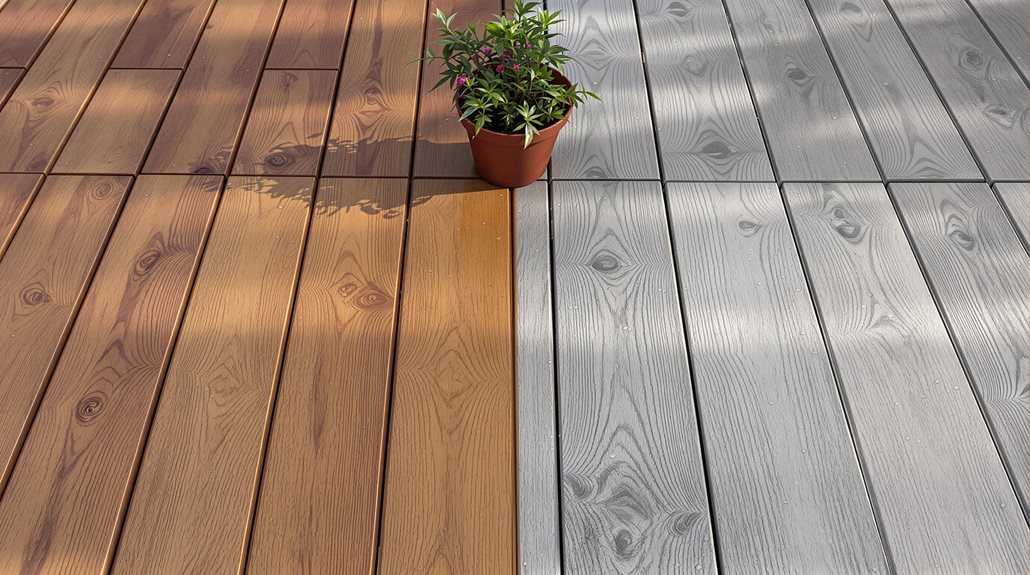Wood Vs Composite Decking: a Complete Comparison Guide for Homeowners
When deciding between wood and composite decking, homeowners face key considerations. Wood decking is initially cheaper but requires frequent maintenance, including staining, sealing, and board replacement, which can be costly in the long run. In contrast, composite decking, though more expensive upfront, offers long-term savings due to its durability and low maintenance needs. Composite decks last up to 25 years with minimal upkeep, outperforming wood decks that typically last 10-15 years. While natural wood provides a classic look, it can warp and fade over time. Composite materials mimic wood's appearance with consistent aesthetics and are made from recycled materials, reducing waste. For a detailed comparison that can help you make an informed decision, continue exploring the differences in cost, durability, maintenance, aesthetic appeal, and environmental impact.
Expert Highlights
- Wood decking is cheaper upfront but requires regular maintenance, while composite decking is more expensive initially but offers long-term savings.
- Composite decking outlasts wood, lasting 25 years or more compared to wood's 10-15 years, with fewer repairs and replacements needed.
- Wood decks need frequent staining, sealing, and inspections, whereas composite decks require only occasional cleaning with mild detergents.
- Natural wood offers a classic appearance but can warp, crack, and fade; composite decking maintains a consistent look with various colors and textures.
- Composite decking is made from recycled materials, reducing waste, though it has a higher carbon footprint during manufacturing compared to wood.
Cost Comparison: Wood Vs Composite Decking

When considering the installation of a deck, one of the most critical factors to evaluate is the cost comparison between wood and composite decking.
Wood decking, particularly pressure-treated lumber or cedar, can be more affordable upfront. However, it requires regular maintenance such as staining, sealing, and replacing rotting boards, which can add significant costs over time.
Composite decking, on the other hand, is generally more expensive initially but offers long-term savings due to its durability and low maintenance requirements. It resists rot, mold, and insect damage without needing frequent treatments.
While composite decking may seem pricey at first, its longevity and minimal upkeep make it a cost-effective choice in the long run. This balance can help homeowners make an informed decision based on their budget and lifestyle.
Working with expert deck builders can help ensure proper material selection and installation techniques that maximize your investment while meeting local building codes and requirements.
Durability and Lifespan of Wood and Composite Decking
When it comes to durability, composite decking generally outperforms traditional wood. Wood decking is prone to warping, cracking, and rotting due to exposure to moisture and sunlight, which can greatly reduce its lifespan.
In contrast, composite decking is made from a mix of plastics and wood fibers, making it more resistant to these elements. Composite decks can last up to 25 years or more with minimal maintenance, whereas wood decks typically need regular staining or sealing and may last around 10-15 years before needing replacement.
This increased durability of composite decking translates into fewer repairs and replacements over time, providing homeowners with a more reliable and long-lasting outdoor living space. For optimal longevity in outdoor spaces, many homeowners choose eco-friendly composite materials that resist fading, staining, and mold growth.
Maintenance Requirements for Wood and Composite Decks

Maintaining a deck is an essential aspect of ensuring its longevity and aesthetic appeal. The maintenance requirements for wood and composite decks differ considerably, impacting the overall experience of homeowners.
Maintenance Requirements
- Wood Decks:
- Regularly apply sealants or stains to protect against weathering and rot.
- Inspect for signs of damage, such as cracks, splits, or insect infestations.
- Perform periodic cleaning to remove dirt and debris.
- Replace rotten or damaged boards to prevent structural issues.
Composite decks, on the other hand, require less maintenance. They are resistant to rot, insects, and weathering, needing only occasional cleaning with mild detergents.
This reduced maintenance burden makes composite decking a popular choice for homeowners seeking a low-maintenance outdoor living space.
Leading manufacturers like TimberTech AZEK produce composite materials specifically designed to minimize upkeep while maintaining a natural wood appearance.
Aesthetic Appeal: Natural Wood Vs Composite Decking
The aesthetic appeal of a deck is a significant factor for homeowners, as it can greatly impact the overall look and feel of their outdoor living space.
Natural wood decking offers a classic, warm, and organic appearance that many homeowners find appealing. However, it can also present challenges such as warping, cracking, and fading over time due to exposure to the elements.
On the other hand, composite decking provides a consistent and durable aesthetic with minimal maintenance required. Composite materials can mimic the look of natural wood while offering a wide range of colors and textures, ensuring a uniform appearance that lasts.
This consistency can enhance the overall aesthetic of the deck, creating a beautifully maintained outdoor area without the hassle of frequent repairs or replacements.
Premium materials like Trex and Timbertech offer superior durability while maintaining the authentic look of natural wood grain patterns.
Environmental Impact of Wood and Composite Decking Materials

When considering the environmental impact of decking materials, it is essential to evaluate the lifecycle effects of both natural wood and composite decking.
Natural wood, while a renewable resource, often requires deforestation and can lead to habitat destruction. On the other hand, composite decking is made from a mix of materials such as recycled plastics and wood fibers, reducing the demand on virgin timber.
- Resource Usage: Natural wood decking relies on trees, potentially contributing to deforestation. Composite decking uses recycled materials, reducing waste and the need for new raw materials.
- Carbon Footprint: The production process for composite decking generally has a higher carbon footprint due to the energy required for manufacturing. However, it can last longer than wood, reducing the need for frequent replacements.
- End-of-Life Disposal: Wood decking can be recycled or repurposed, while composite decking is often sent to landfills at the end of its life cycle.
- Sustainability Certifications: Look for sustainability certifications like FSC (Forest Stewardship Council) for wood and eco-friendly labels for composite products to guarantee environmentally responsible choices.
Professional construction services can ensure proper installation to maximize the longevity and environmental benefits of either material choice.
Frequently Asked Questions
Can I Install Wood or Composite Decking Myself?
Installing wood or composite decking oneself is feasible but requires careful planning, proper tools, and some DIY expertise. It involves measuring, cutting, and securing the decking material, ensuring proper spacing and support. Beginners may find it challenging due to the physical labor and technical skills required.
How Do Wood and Composite Decks Handle Extreme Weather Conditions?
Wood decks can warp, rot, and crack in extreme weather, while composite decks are more resilient to moisture, heat, and cold. Composite materials resist warping and fading better than wood, offering longer durability.
Are There Any Specific Building Codes for Wood and Composite Decks?
Building codes for wood and composite decks vary by region but generally include standards for structural integrity, material specifications, and safety features like railings and stairways. Local building authorities enforce these codes to guarantee public safety.
Can I Use Both Wood and Composite Materials in the Same Deck?
Homeowners can indeed use both wood and composite materials in the same deck, but they must guarantee compatibility and adherence to local building codes. Mixing materials requires careful planning to maintain structural integrity and aesthetic coherence.
Do Wood and Composite Decks Require Special Cleaning Products?
Wood decks often require specialized cleaning products to protect the natural material, while composite decks can typically be cleaned with mild soap and water, avoiding harsh chemicals that might damage the surface.
Expert Final Thougts
When deciding between wood and composite decking, homeowners must weigh several key factors. While wood offers a natural aesthetic and lower initial cost, it requires regular maintenance to prevent rot and decay. Composite decking, though more expensive upfront, provides durability and minimal upkeep, making it a long-term cost-effective option. Considering environmental impact, composite materials often use recycled plastics, reducing waste. Ultimately, choosing the right material depends on your priorities: appearance, budget, maintenance, and sustainability.





